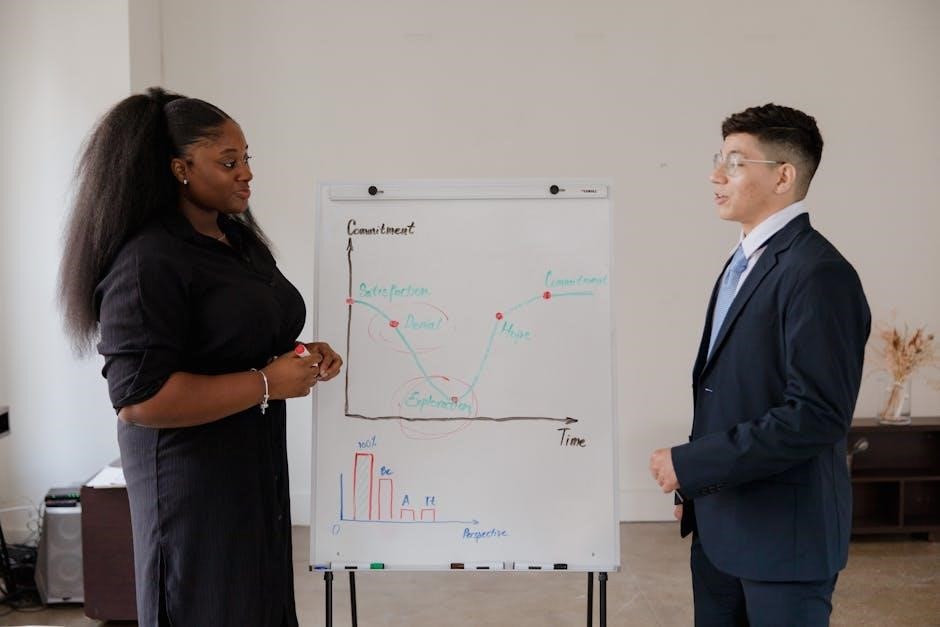Decimal to fraction conversion charts are essential tools for simplifying numerical transitions, offering precise equivalents and enhancing mathematical accuracy across various fields, from education to professional applications.
Overview of Decimal to Fraction Conversion
Decimal to fraction conversion is a fundamental mathematical process that enables the representation of decimal numbers as fractional values. This conversion is crucial for various applications, including education, cooking, and engineering, where precise measurements are essential. A decimal to fraction conversion chart provides a quick reference guide, mapping common decimals to their equivalent fractions. For instance, 0.5 corresponds to 1/2, while 0.25 is equivalent to 1/4. These charts are particularly useful for simplifying calculations and ensuring accuracy. They are widely used in classrooms to teach students about numerical relationships and in professional settings to streamline tasks. By standardizing conversions, these charts eliminate the need for complex calculations, making them an indispensable tool for both learners and professionals.
Importance of Conversion Charts
Conversion charts are invaluable for ensuring accuracy and efficiency in numerical tasks. They provide a straightforward method to translate decimals into fractions, eliminating the need for complex calculations. These charts are particularly beneficial in education, helping students grasp mathematical concepts visually. Professionals, such as engineers and chefs, rely on them for precise measurements. Conversion charts also save time by offering instant references, reducing errors in critical applications. Their standardized format ensures consistency across different fields, making them a reliable tool for both learning and professional environments. By simplifying the conversion process, these charts enhance productivity and accuracy, making them an essential resource for anyone working with numbers.

Understanding Decimals and Fractions
Decimals and fractions are two ways to represent parts of a whole. Decimals use a decimal point, while fractions use a numerator and denominator to show division.
What Are Decimals?
Decimals are numerical values that represent parts of a whole using a decimal point. The digits before the decimal point indicate whole numbers, while those after represent fractions. For example, 0.5 equals half, and 0.25 equals a quarter. Decimals are widely used in everyday applications, such as currency, measurements, and scientific calculations, due to their precision and simplicity. They provide a straightforward way to express fractions without using symbols like numerator and denominator. Understanding decimals is fundamental for various mathematical operations and real-world problem-solving. Their structure allows for easy conversion to fractions, making them a versatile tool in education and professional fields. Accurate use of decimals ensures clarity and avoids errors in calculations.
What Are Fractions?
Fractions are mathematical expressions representing a part of a whole, consisting of a numerator and a denominator. The numerator indicates the number of equal parts, while the denominator shows how many parts make up the whole. For instance, in 1/2, the numerator is 1, and the denominator is 2, meaning one part out of two. Fractions can be proper, improper, or mixed, and they are essential in various applications, including cooking, construction, and finance. They provide a clear way to express division and ratios, making them a fundamental concept in arithmetic and algebra. Understanding fractions is crucial for problem-solving and real-world applications, where precise measurements and divisions are necessary. Their versatility allows for easy conversion to decimals, enhancing their utility in diverse contexts.
Key Differences Between Decimals and Fractions
Decimals and fractions are both numerical representations but differ in form and usage. Decimals express values in base 10, using a decimal point to separate whole numbers from fractions, like 0.5 or 3.14. Fractions, however, represent parts of a whole as a ratio of two integers, such as 1/2 or 3/4. Decimals are often preferred for measurements and scientific applications due to their simplicity and ease of comparison. Fractions, while more visual and intuitive for certain tasks like cooking or construction, can be less straightforward for complex calculations. Both systems are interchangeable through conversion, allowing flexibility in problem-solving. Understanding their differences aids in choosing the most appropriate representation for specific tasks, enhancing accuracy and efficiency in various fields.

The Conversion Process

The conversion process involves identifying the decimal’s place value and expressing it as a fraction, ensuring accuracy and simplicity for various applications by simplifying the fraction when possible.
Step-by-Step Guide to Converting Decimals to Fractions
To convert decimals to fractions, start by identifying the place value of the last digit in the decimal. This determines the denominator, such as tenths, hundredths, or thousandths. Next, write the decimal as a fraction with the decimal number over the place value. For example, 0.5 becomes 5/10. Simplify the fraction by dividing both the numerator and denominator by their greatest common divisor. If the decimal is greater than 1, separate the whole number and convert the decimal part to a fraction, then combine them. Using a conversion chart can streamline this process and ensure accuracy, especially for common decimals like 0.25, which is 1/4, or 0.75, which is 3/4. Always check if the fraction can be reduced further to its simplest form. This method works for both terminating and repeating decimals, though repeating decimals may require additional steps. By following these steps, anyone can efficiently convert decimals to fractions, making it easier to use them in various mathematical operations or real-world applications where fractions are preferred. This guide provides a clear, systematic approach to mastering decimal to fraction conversion, whether for academic purposes or practical use. The key is to understand the relationship between decimals and fractions, as they are different representations of the same value. With practice, converting decimals to fractions becomes a straightforward process that enhances numerical understanding and problem-solving skills. Using a conversion chart as a reference can also help reinforce this process and reduce errors, especially for those new to working with fractions and decimals. By breaking down the conversion into manageable steps, individuals can confidently handle even complex conversions, ensuring accuracy and precision in their work. This step-by-step approach is particularly useful in educational settings, where students can follow along and apply the method to various problems, gradually building their proficiency in handling decimals and fractions. The ability to convert between these two forms of numbers is a fundamental skill that supports learning in mathematics, science, and engineering, making this guide an invaluable resource for anyone seeking to improve their numerical literacy. Additionally, understanding how to convert decimals to fractions can enhance one’s ability to work with measurements, ratios, and proportions, which are essential in fields like cooking, construction, and finance. By mastering this conversion process, individuals can approach a wide range of tasks with greater confidence and accuracy, knowing they have a solid foundation in numerical representation and manipulation. This guide serves as a comprehensive resource for anyone looking to improve their skills in converting decimals to fractions, providing clear instructions and practical examples to facilitate learning and application. Whether for academic success or professional advancement, the ability to convert decimals to fractions is a valuable skill that opens doors to deeper understanding and problem-solving capabilities in numerous areas. The step-by-step method outlined here ensures that learners of all levels can grasp the concept and apply it effectively, making it an essential tool for anyone working with numbers. Furthermore, the use of a conversion chart alongside this guide can act as a quick reference, helping to reinforce the learning process and provide a handy resource for double-checking work. By combining theoretical knowledge with practical application, this guide equips individuals with the skills needed to handle decimal to fraction conversions with ease and precision, making it an indispensable asset in both educational and professional contexts. The systematic approach ensures that each step is clear and easy to follow, reducing confusion and minimizing errors. This, in turn, builds confidence and fluency in working with decimals and fractions, which are fundamental components of mathematical literacy. In conclusion, this step-by-step guide offers a thorough and accessible method for converting decimals to fractions, supported by the use of conversion charts, making it an excellent resource for learners and professionals alike. By following the outlined steps and practicing regularly, anyone can master the art of decimal to fraction conversion, unlocking a world of numerical possibilities and applications. The guide’s emphasis on simplicity and clarity ensures that even complex conversions become manageable, while its focus on accuracy and precision makes it a reliable tool for achieving success in various fields. Ultimately, the ability to convert decimals to fractions is not just a mathematical skill but a valuable asset that enhances problem-solving abilities and opens up opportunities for further learning and growth. With this guide, individuals can take the first steps toward mastering this essential skill, paving the way for greater academic and professional achievements. The process outlined here is designed to be both educational and practical, providing a solid foundation for understanding and applying decimal to fraction conversions in real-world scenarios. By adhering to the steps and utilizing the conversion chart, learners can ensure that their conversions are accurate and efficient, making this guide a trusted companion in their journey toward numerical proficiency. In summary, this step-by-step guide is an invaluable resource for anyone seeking to improve their ability to convert decimals to fractions, offering a clear, methodical approach that combines theoretical understanding with practical application. Its emphasis on accuracy, simplicity, and reinforcement through the use of conversion charts makes it an essential tool for learners at all levels, helping them to grasp and apply this fundamental mathematical concept with confidence and precision.
Common Methods for Conversion
Several methods exist for converting decimals to fractions, each offering unique advantages. The place value method involves identifying the decimal’s place value to determine the denominator, such as tenths or hundredths. For example, 0.5 becomes 5/10, which simplifies to 1/2. Another approach is the simplification method, where decimals are directly converted to fractions and then reduced to their simplest form. Mixed numbers can be handled by separating the whole number and converting the decimal part. Additionally, repeating decimals require a different technique, often involving algebra to find their fractional equivalents. Using a conversion chart is a quick and accurate way to find common decimal-to-fraction equivalents, making it a popular choice for both students and professionals. These methods ensure precision and efficiency in various mathematical and real-world applications.
Using a Conversion Chart for Accuracy
A decimal to fraction conversion chart is a reliable tool for ensuring accuracy in numerical transitions. By standardizing common decimal values, these charts eliminate the risk of human error. For instance, 0.5 is universally equivalent to 1/2, and 0.25 corresponds to 1/4. Users can quickly reference these charts to find precise fractional representations without complex calculations. This method is particularly useful for recurring decimals, such as 0.333… (1/3) or 0.666… (2/3). The chart also simplifies mixed numbers and improper fractions, making it a versatile resource for both beginners and professionals. By leveraging a conversion chart, individuals can streamline their workflow and maintain consistency in their calculations.
Creating a Decimal to Fraction Conversion Chart
Building a decimal to fraction chart involves organizing common conversions, ensuring accuracy and ease of use for quick reference in various mathematical and practical applications.
How to Build a Comprehensive Chart
Building a comprehensive decimal to fraction chart involves systematic organization. Start by listing common decimals, such as 0.1 to 1.0, and determine their place value. For each decimal, identify its equivalent fraction by considering the denominator as a power of 10. For example, 0.5 becomes 1/2. Include multiple examples for each place value to ensure coverage. Organize the chart in a table format, with decimals in one column and fractions in another. Add visual separators for clarity. Include simplified fractions and mixed numbers where applicable. Verify accuracy by cross-checking conversions. Finally, format the chart for readability, using clear headings and consistent spacing. This ensures it is user-friendly and accessible for quick reference.
Tools and Resources for Chart Creation
Creating a decimal to fraction conversion chart requires reliable tools and resources. Spreadsheets like Excel or Google Sheets are ideal for organizing and calculating conversions. Online fraction calculators can verify accuracy. PDF editors like Adobe Acrobat or free alternatives enable professional formatting. For precise layouts, design tools such as Canva or Microsoft Word offer templates and customization options. Additionally, educational websites and math forums provide sample charts and tips for clarity. Using these tools ensures the chart is both functional and visually appealing. Proper formatting enhances readability, making the chart a valuable resource for learners and professionals alike. These resources streamline the creation process, ensuring accuracy and efficiency.

Applications of the Conversion Chart
A decimal to fraction conversion chart simplifies numerical transitions, aiding in education, engineering, cooking, and finance. It ensures accuracy and versatility across various professional and everyday tasks.
Mathematical Problem Solving
Decimal to fraction conversion charts are invaluable in mathematical problem solving, providing precise equivalents for decimals, which are often required in algebra, geometry, and calculus. By using these charts, students and professionals can quickly convert decimals like 0.5 to 1/2 or 0.25 to 1/4, ensuring accuracy in calculations. This tool is particularly useful in scenarios where fractions are more intuitive, such as in probability, statistics, and measurement conversions. The charts also aid in simplifying complex expressions and equations, making problem-solving more efficient. Additionally, they serve as a reliable reference for verifying results, reducing errors in exams and professional projects. Their simplicity and effectiveness make them a cornerstone in mathematical education and practice.
Engineering and Technical Fields
Decimal to fraction conversion charts are indispensable in engineering and technical fields, where precision is critical. Engineers often require exact fractional values for designs, specifications, and calculations. For instance, converting 0.125 to 1/8 ensures accuracy in machining and manufacturing processes. These charts also simplify complex technical drawings and blueprints, where fractions are commonly used. In architecture and construction, precise measurements are vital, and conversion charts help avoid errors in material cutting and assembly. Additionally, they are invaluable in technical education, aiding students in understanding and applying mathematical concepts effectively. By providing quick and accurate conversions, these charts enhance efficiency and reliability in technical problem-solving and execution.
Culinary and Baking Measurements
Decimal to fraction conversion charts are invaluable in culinary and baking, where precise measurements are essential for achieving desired results. Bakers and chefs often work with fractions, such as 1/4 or 3/8, to ensure recipe accuracy. For example, converting 0.25 to 1/4 or 0.375 to 3/8 simplifies ingredient measurements. These charts are particularly useful for scaling recipes up or down, maintaining consistency in flavors and textures. They also aid in converting between units, such as tablespoons to teaspoons, ensuring no detail is overlooked. Whether for home cooking or professional kitchens, decimal to fraction charts streamline the process, reducing errors and saving time. This resource is a must-have for anyone passionate about precise and delicious culinary creations.

Financial Calculations
Decimal to fraction conversion charts are crucial in financial calculations, where precision is paramount. Professionals rely on these tools to accurately convert decimals to fractions, ensuring error-free computations in budgeting, tax calculations, and investment returns. For instance, converting 0.0625 to 1/16 or 0.125 to 1/8 simplifies percentage-based calculations, such as interest rates or portfolio allocations. These charts are also essential for creating clear financial reports and proposals, where fractions often represent proportions of budgets or assets. By streamlining conversions, they reduce the risk of miscalculations, fostering confidence in financial decision-making. Whether for personal finance or corporate planning, decimal to fraction charts are indispensable resources for achieving accuracy and efficiency.
Common Mistakes and Solutions
Common errors include incorrect decimal placement and improper fraction reduction. Solutions involve double-checking conversions, using charts for accuracy, and simplifying fractions correctly to avoid miscalculations.
Errors in Decimal Placement

Errors in decimal placement are common, leading to incorrect fraction conversions. Misplacing decimals can result in fractions that are too large or too small. For example, 0.5 should be 1/2, not 1/5. To avoid this, always align the decimal point correctly when converting. Using a conversion chart can help ensure accuracy. Pay attention to the position of the decimal in the original number and transfer it precisely. Double-checking work is crucial. Another tip is to break down decimals into tenths, hundredths, and thousandths for clearer understanding. Proper alignment and careful reading of decimals will minimize errors and ensure precise fraction equivalents. This step is foundational for accurate conversions.

Incorrect Fraction Reduction
Incorrect fraction reduction is a frequent mistake during decimal to fraction conversion. It occurs when fractions are simplified improperly, leading to inaccurate results. For instance, reducing 0.25 to 1/4 is correct, but reducing 0.50 to 1/2 instead of 1/1 is a common error. To avoid this, ensure the numerator and denominator are divided by their greatest common divisor (GCD). Always double-check reductions, especially with complex decimals. Using a conversion chart can help verify results. Additionally, breaking down decimals into their place values (tenths, hundredths) before converting can minimize errors. Proper reduction ensures fractions are in their simplest form, maintaining mathematical integrity and accuracy in calculations. This step is crucial for reliable outcomes in various applications.
Best Practices for Avoiding Mistakes

To ensure accuracy in decimal to fraction conversion, follow best practices. Always double-check your work, especially decimal placement and fraction reduction. Use a conversion chart as a reference to verify results. Understand the place value of decimals (e.g., tenths, hundredths) before converting. Simplify fractions by dividing numerator and denominator by their greatest common divisor (GCD). Avoid rushing through calculations, as this increases error likelihood. Use visual aids like charts or diagrams to enhance understanding. When uncertain, cross-verify with online tools or consult additional resources. Consistency and attention to detail are key to avoiding mistakes and achieving precise conversions. These practices foster confidence and reliability in your results.
Future of Decimal to Fraction Conversion
The future of decimal to fraction conversion lies in advanced digital tools and AI-driven platforms, enhancing accuracy and accessibility for educational and professional applications globally.
Role of Technology in Conversion
Technology has revolutionized decimal to fraction conversion by providing automated tools and calculators, ensuring precision and speed. Software and apps now offer real-time conversions, reducing manual errors. AI-driven platforms enhance accuracy, while interactive charts simplify complex processes. Online converters enable instant access, making conversions accessible anytime, anywhere. These advancements not only streamline workflows but also empower users across education, engineering, and finance. The integration of technology ensures that decimal to fraction conversion charts remain dynamic and adaptable, catering to diverse needs. As innovation progresses, these tools will continue to play a pivotal role in maintaining efficiency and accuracy in numerical conversions.
Online Tools and Apps
Online tools and apps have become indispensable for decimal to fraction conversions, offering instant and accurate results. These platforms provide user-friendly interfaces, allowing individuals to input decimals and receive precise fractional equivalents. Many tools support real-time conversions, enabling quick adjustments and multiple calculations. Popular options include decimal to fraction converters and fraction calculators, which often feature additional functionalities like simplification and comparison. Mobile apps further enhance accessibility, allowing conversions on-the-go. Some tools also generate printable conversion charts, making them ideal for educational purposes. With advanced algorithms and intuitive designs, online tools and apps have transformed how we approach decimal to fraction conversions, ensuring efficiency and accuracy for all users.
Advancements in Conversion Resources
Recent advancements in conversion resources have significantly enhanced the efficiency and accuracy of decimal to fraction conversions. Modern tools now incorporate interactive charts, AI-driven converters, and real-time calculators, making the process seamless. These resources often include features like customizable charts, printable formats, and educational guides, catering to diverse user needs. Mobile apps and web-based platforms have further expanded accessibility, allowing users to convert decimals to fractions anywhere. Additionally, advancements in software have improved the precision of conversions, especially for complex decimals. These innovations ensure that users across industries, from education to engineering, can rely on accurate and efficient conversion resources, streamlining their workflows and decision-making processes.

Final Thoughts on the Importance of Conversion Charts
Conversion charts remain indispensable tools for decimal to fraction conversions, offering reliability and accessibility for users of all skill levels. Their structured format simplifies complex numerical transitions, making them invaluable in education and professional settings. By providing clear, precise equivalents, these charts reduce errors and save time, especially in high-stakes environments like engineering or finance. Their versatility across various fields, from culinary measurements to mathematical problem-solving, underscores their universal utility. Even as technology advances, conversion charts serve as a foundational resource, ensuring accuracy and understanding. Their enduring relevance highlights the importance of having robust, user-friendly tools for seamless numerical conversions, catering to both learning and practical applications.
